Overview - Help topics
- Input parameters
- Burst parameters
- Extinction
- Cosmological parameters
- Output configuration
Input Physics: stellar evolution, stellar spectral library and
initial mass function
The choice of
"Initial Mass Function" determines the full set of input physics, not only the
IMF alone.
This input physics is:
1) Stellar evolution currently
includes:
- stellar isochrones of the
Padova
group as it was in 1999, hence including TP-AGB, but not yet the later
Girardi et al. 2000 or Salasnich et al. 2000 or Marigo 2001 models
-
isochrones for 0.15, 0.3 and 0.45 Msun have been added from the work of Baraffe
and Chabrier
2) Stellar spectral atmosphere library
described in Lejeune (1997,
A&AS 125,
229) and Lejeune (1998,
A&AS 130, 65)
(called BaSeL 2.0)
3) Initial Mass Function Here
you can choose between a range of common IMFs
- Salpeter (1955), described by P(M) = M-a, where a=2.35.
- Kroupa (2001, MNRAS 322, 231), a
broken power-law mass function with P(M) = M-ai, where ai=1.3 for
0.1<M/Mo<0.5 and ai=2.3 for M/Mo>0.5.
The lower mass limit is defaulted to be 0.1 Mo, the upper
mass-limit can be chosen to be either 100Mo or 120Mo.
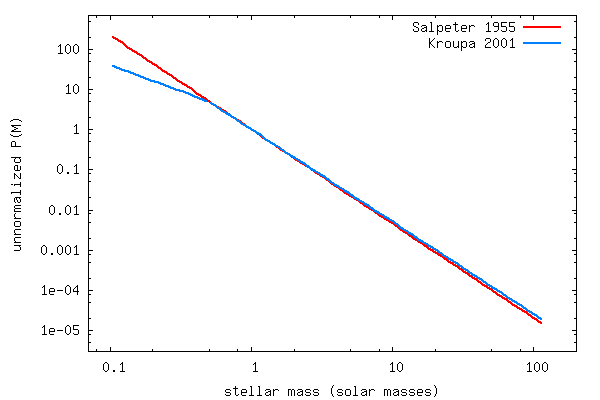 (back to top)
(back to top)
Gaseous emission: Continuum and lines
Here you have three options to choose from:
- No gaseous emission
- Continuum emission only
This includes bound-free emission from hydrogen
and helium, free-free emission and emission from the hydrogen
two-photon process.
- Contiuum and line emission
In addition to the continuum emission, this
also contains emission lines for a wide range of elements. Line emission for
hydrogen lines is computed on basis of atomic physics and the total number of
ionizing photons. Lines of heavier elements (e.g. C, N, O) are computed from
observed line-ratios relative to H-beta.
(back to top)
Initial/Total mass
The total mass of the galaxy, given in solar masses Msun. At the beginning all
the mass is "gaseous". This changes due to star formation and stellar
evolution.
Note that our models currently do not reproduce observed mass-metallicity
relations, i.e. the mass is a mere scaling factor.
(back to top)
Galaxy types
The crucial factor describing and determining the galaxy type is the galaxy's
star formation history (SFH).
In principal there are three different possibilities:
- An exponentially declining star formation rate (SFR),
typical for early-type galaxies, i.e. ellipticals
- A SFR that is proportional to the available gasmass as
predicted from the Kennicutt-Schmidt law. This SFH is typically
observed in spiral galaxies
- A constant SFR that is commonly used to describe the SFH of
late-type spirals (Sd's)
By choosing the respective spectral galaxy type E, Sa...Sd you
automatically choose the predefined parameters for the SFH of above
galaxies that best represent today's observations.
If you, however, want to define your own model parameters (e.g. a
different characteristic for an elliptical galaxy), you should instead
choose one of the free types. The available parameters are described below (
SFR,
DECLFAK,
SFRFAK)
The plot below shows the SFHs of the five predefined types, all normalized to a
total mass of 10
6 solar masses.
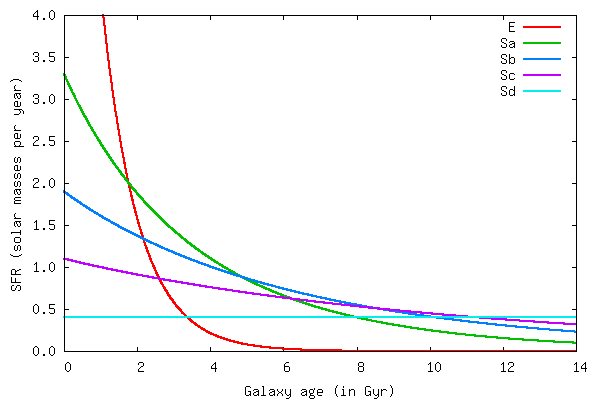 (back to top)
(back to top)
SFR0 (only for free Sd)
This parameter that is only available for the galaxy type "free Sd" specifies the
constant SFR in units of solar masses per year.
SFR = SFR0 x Mtot / 1010
(back to top)
SFRFAK (only for free E & Sabc types)
This parameter specifies the star formation rate of a user-defined spiral type
model. The time-dependent star formation rate in this case is given by
SFR(t) = Mgas/109 x SFRFAK
This is hence equivalent to an inverse characteristic timescale for the star
formation. A SFRFAK of 0.2 means a timescale of 5 Gyr, while a SFRFAK=1 means a
timescale of just 1 Gyr.
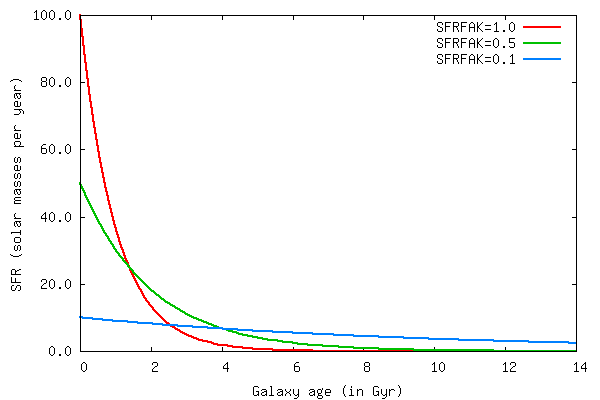 (back to top)
(back to top)
DECLFAK (Decline factor, only for free E-type)
The DECLFAK (Decline factor) parameter specified the characteristic timescale
for the SFR of an elliptical galaxy. The SFR is then given by:
SFR(t) = (Mtot / SFRFAK) x exp(-t/DECLFAK)
Besides the decline time the second important parameter is SFRFAK. The value of
this parameter can be tuned in such a way to minimize the remaining gasmass.
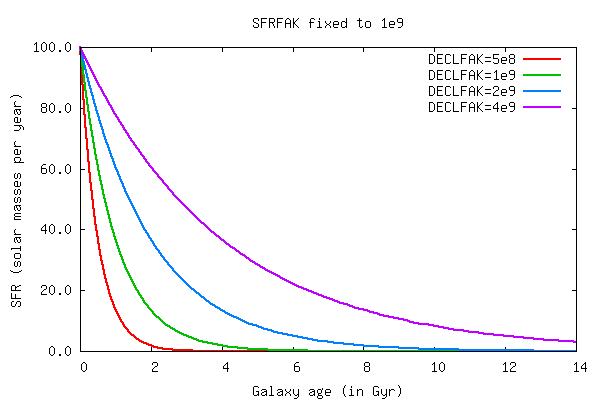
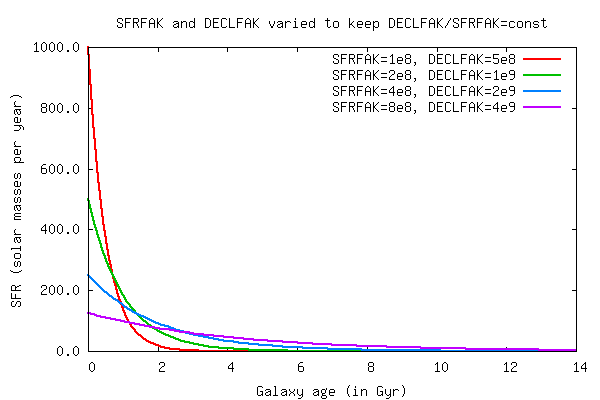 (back to top)
(back to top)
All stars in the galaxy will have the same metallicity specified here, unless
"chemically consistent" has been chosen. The choices are:
- chemically consistent modelling: Switch to chemically consistent modelling.
- [Fe/H] = -1.7, equivalent to Z = 0.0004 = 1/50 Zo
- [Fe/H] = -0.7, equivalent to Z = 0.004 = 1/5 Zo
- [Fe/H] = -0.4, equivalent to Z = 0.008 = 2/5 Zo
- [Fe/H] = 0.0, equivalent to Z = 0.02 = Zo (this means solar metallicity)
- [Fe/H] = +0.4, equivalent to Z = 0.05 = 2.5 Zo
(back to top)
Burststrength
GALEV defines the strength of burst as the fraction of the available gas at the
onset of burst that is transformed into stars during the burst:
Burststrength = Mass of formed stars / Mass of available gas
The burst strength therefore can only have values of between 0 and
1. Furthermore note that since the burststrength includes the mass of gas that
is available at the beginning of the burst, the same value for the burststrength
can result in different amounts of newly formed stars depending on galaxy type
and time of burst. A weak burst (e.g. 20 %) early in the evolution of a Sd-type
galaxy can form more stars than a strong burst (75 %) in a already old Sa
galaxy.
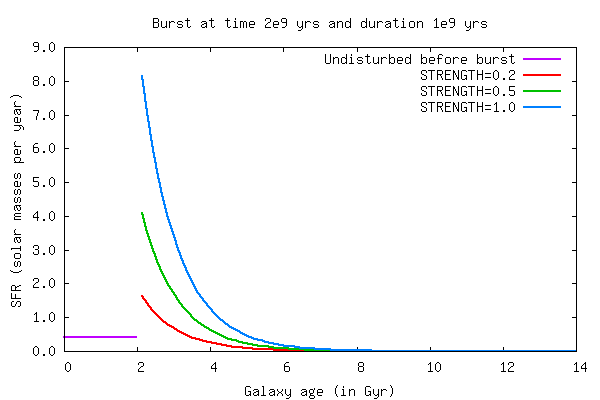 (back to top)
(back to top)
Burst duration
The parameter burst duration specifies the e-folding time for the exponentially
declining SFR during the burst. Before the onset of the burst (see parameter
burst time the SFR is determined by the parameters for the
undisturbed galaxy.
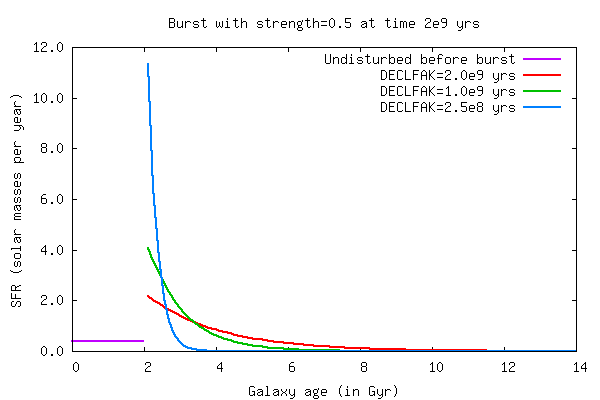 (back to top)
(back to top)
Bursttime
This parameter simply determines at which age of the galaxy the burst should
occur. The value needs to be given in years, so an age of 10 Gyr should be
entered as 10e9.
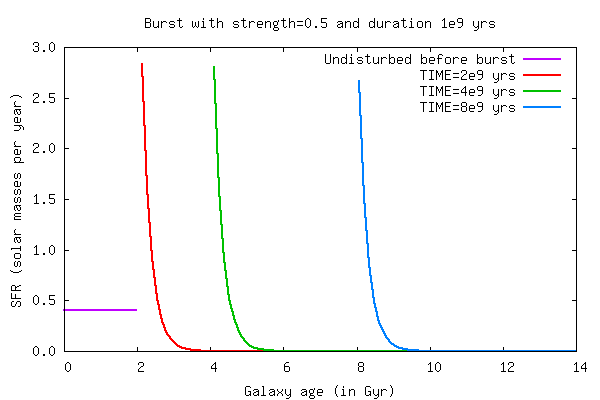 (back to top)
(back to top)
Extinction
We currently offer two different extinction laws:
- Calzetti (2000, ApJ 533, 682)
- Cardelli (1989, ApJ 345, 245)
You can choose a maximum extinction value and the step width between the
individual extinction values. All magnitudes and spectra (depending on which
output was requested, see below) are then computed for each extinction value in
this range.
(back to top)
Cosmology: Hubble constant, Omega-factors and formation redshifts
Here you can choose the requested cosmology. Note that if no cosmology
output is requested, the values are ignored during the execution of COCOS and
hence should be left at their default values.
You can change the following parameters:
- Hubble constant
- Matter content, Omega M
- Omega Lambda
- The value for Omega Curvature is fixed to be 0.00, hence limiting the
cosmology to a flat universe.
- Due to the special nature of COCOS, the user furthermore has to specify a
formation redshift. This is needed to convert galaxy ages to
redshifts.
- One can also specify a maximum redshift. The cosmological output is
then only given for redshifts smaller than the given value. This can for example
be used to limit the output for models with burst or truncation to times when
the burst has already occured, rejecting the evolution of the original
undisturbed galaxy. Note that this only affects the cosmological output, GALEV,
its spectra and the time evolution of colours are not affected by this.
(back to top)
Time evolution - Spectra
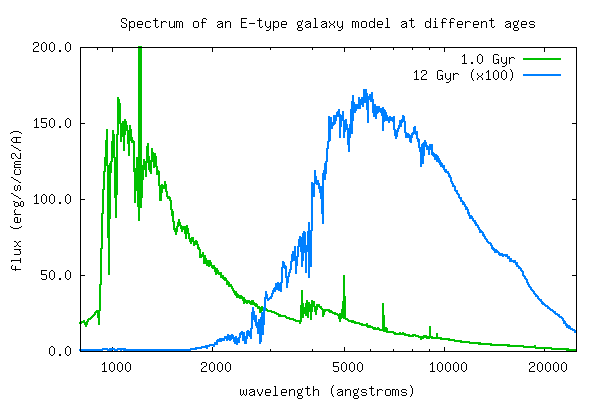 (back to top)
(back to top)
Time evolution - Magnitudes and Colours

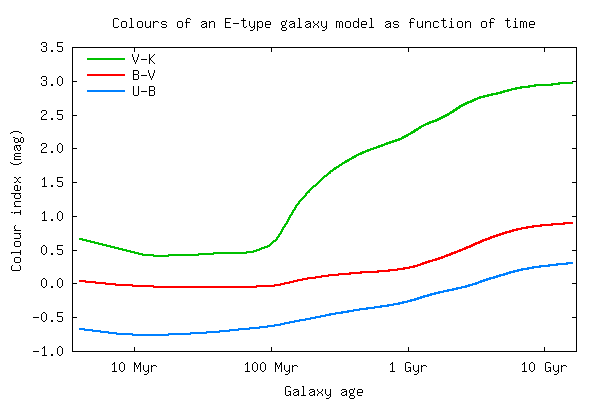 (back to top)
(back to top)
Time evolution - Statistics & Diagnostics:
SFR, stellar
and gas-mass, gaseous metallicity
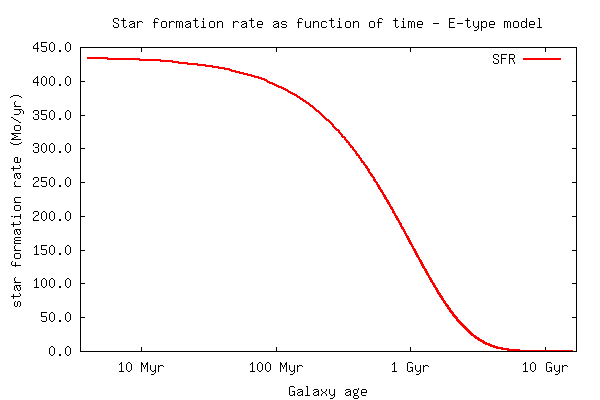

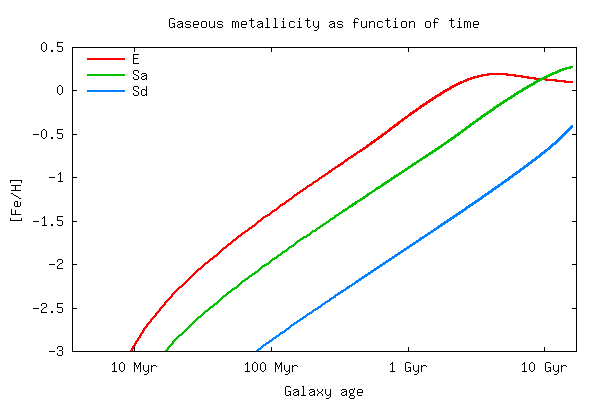 (back to top)
(back to top)
Cosmology - specs
(back to top)
Cosmology - absolute magnitudes
(back to top)
Cosmology - appmag
(back to top)
Cosmology - attmag
(back to top)
Cosmology - ecorr
(back to top)
Cosmology - kcorr
(back to top)
Cosmology - stat
(back to top)
Normalization
(back to top)















